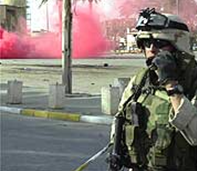

The small amount of deadly nerve agent sarin dispersed by a shell that exploded near a U.S. military convoy apparently was left over from Saddam Hussein's banned chemical arsenal built up two decades ago.
Two former weapons inspectors, Hans Blix and David Kay, said the shell probably was a stray weapon scavenged by militants. It likely does not signify that Iraq still had stockpiles of weapons of mass destruction, they said.
Kay, who led a U.S. team hunting for such weapons, said it appears the sarin shell was one of tens of thousands produced for the Iran-Iraq war in the 1980s. The shells were banned by the United Nations after the first Gulf War, and Saddam said he had destroyed them all in the mid-1990s.
"It is hard to know if this is one that just was overlooked — and there were always some that were overlooked, we knew that — or if this was one that came from a hidden stockpile," Kay said. While the explosion demonstrates that Saddam hadn't complied fully with U.N. resolutions, Kay added, "It doesn't strike me as a big deal."
U.S. military and other government officials said it was uncertain if more weapons containing sarin exist and are in the hands of insurgents. They also said that the insurgents who rigged the shell to explode may have been unaware it contained a chemical weapon.
Two U.S. soldiers, members of a military bomb squad, were treated for exposure to sarin. Officials said there were no serious injuries.
Brig. Gen. Mark Kimmitt, the chief military spokesman in Iraq who disclosed the discovery Monday, said a U.S. convoy in Baghdad found the substance a few days ago in an artillery shell. The shell, inside a bag that had been rigged as a roadside bomb, exploded as the bomb squad was attempting to defuse it Saturday.
"This produced a very small dispersal of agent," Kimmitt said.
The shell was of a "binary" type that requires mixing of chemicals, usually by an explosion in the air over a target. Since the shell exploded on the ground, the chemical mixing did not occur as completely as needed to make it deadly, according to preliminary CIA and U.S. military analysis.
The nerve agent is a chemical weapon, one of several types of weapons of mass destruction that President Bush asserted Saddam possessed in making the case for the U.S.-led invasion of Iraq last year. No such stockpiles have been found and administration officials reacted cautiously to the sarin finding. Defense Secretary Donald Rumsfeld said more testing needs to be done to confirm tests done in the field.
Ewen Buchanan, a spokesman for U.N. weapons inspectors, said Iraq produced hundreds of tons of sarin in the 1980s. In the mid-1990s, under international pressure, Saddam's regime admitted to testing binary artillery shells filled with sarin.
According to a U.N. report last year, Iraq claimed that there was "no industrial-scale production" of the agent. During the early 1990s after the Persian Gulf War, Iraq emptied many of its sarin shells under U.N. supervision. The sarin agent has a limited shelf life unless stored under carefully controlled conditions, Buchanan said.
Daryl Kimball, executive director of the Arms Control Association, said it would not be surprising for Iraqi insurgents to accidentally use an old sarin artillery shell in an improvised explosive device.
"If they used this old shell to build bombs, it's not surprising they would use one that had sarin because there were so many of them before the Gulf War," Kimball said. "This does not constitute evidence that (President) Bush, (CIA Director George) Tenet, (national security adviser Condoleezza) Rice and Rumsfeld were right" that Saddam still had weapons of mass destruction before the United States sent troops into Iraq last year.
In 1995, Japan's Aum Shinrikyo cult unleashed sarin gas in Tokyo's subways, killing 12 people and sickening thousands. In February of this year, Japanese courts convicted former leader Shoko Asahara and sentenced him to death.
Sarin was developed in the mid-1930s by Nazi scientists. A single drop can cause quick, agonizing death from choking. There are no known instances of the Nazis using the nerve agent.



















